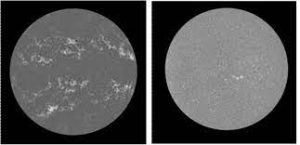Equal Contrast Technique (ECT):

Scientists developed a new methodology, called Equal Contrast Technique (ECT), to analyse Sun images in white light, which can help prevent temporal and latitudinal variations in observations related to instrument and sky conditions.
- It is known that there are large numbers of regions of weak magnetic field on the sun, which vary with time.
- These can be studied using magnetograms and Ca-K line images of the sun, as there is a strong correlation between the magnetic field and the Ca-K line intensity of the region on the Sun.
- The magneto-grams are available for short periods, and the characteristics of the instrument change with time.
- Ca-K line images have been available for a long period at Kodaikanal Observatory (KO), for more than 100 years, with no change in the optics of the instrument.
- Similarly, other observatories in the world, such as Mount Wilson Observatory (MWO) have had this type of data for about 70 years.
- Using the data obtained at Kodaikanal observatory, the scientists have shown that the correlation between derived plage area (the bright region in the sun’s chromosphere) from the Ca-K images and sunspot number is excellent, even on a daily basis, over a period of about 100 years for the first time.
- This type of accurate analysis of the historical time series of Ca-K images can be useful for reliable and accurate investigation of variations on the sun and the effect of this on the climatic condition of the earth.
- It helps in understanding the dynamics of the sun, solar cycle variations, dynamo processes in the convection zone and resulting long-term climatic variations on the earth.




